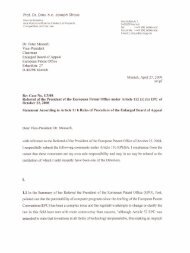Assessing the Obstacles to Industrialisation: The ... - Innovation
Assessing the Obstacles to Industrialisation: The ... - Innovation
Assessing the Obstacles to Industrialisation: The ... - Innovation
You also want an ePaper? Increase the reach of your titles
YUMPU automatically turns print PDFs into web optimized ePapers that Google loves.
- -I 8Stephen H. Haberdollars) in 1910, compared <strong>to</strong> $807 in Great Britain and !$1,03j in <strong>the</strong>United States.'" In addition, <strong>the</strong> distribution of this income was highlyskewed. A redundant labour force and highly capital-intensive methods ofproduction suggest that most of value added went <strong>to</strong> capital, not <strong>to</strong>labour. In fact, <strong>the</strong> income of <strong>the</strong> average household was so low that <strong>the</strong>consumption of cot<strong>to</strong>n cloth was highly sensitive <strong>to</strong> changes in <strong>the</strong> priceof corn, which along with beans and chiles made up <strong>the</strong> largest part of<strong>the</strong> diet of Mexico's working class."This uneven and limited market had <strong>to</strong> combine with a relativelysophisticated and expensive technological base. hlexico now had a larger,better integrated market than it did in <strong>the</strong> 184os, but <strong>the</strong>re had also beensignificant changes in manufacturing technologies since that time, puttingmany industries out of Mexico's reach. In general, <strong>the</strong>se advances loweredunit costs of production by taking advantage of economies of scale andeconomies of speed. Thus, <strong>the</strong> optimal size (<strong>the</strong> scale of production atwhich unit variable costs would be minimised) of firms increasedsubstantially. This not only prevented Mexico from entering many lines ofmanufacturing, but also shaped <strong>the</strong> industries which did develop inseveral significant ways.Since <strong>the</strong> minimum-efficient scale in capital goods production hadincreased, and since capital goods industries now required well-developedscientific and engineering capabilities, Mexico had little choice but <strong>to</strong>import its capital equipment.46 Thus, hlexico's blast furnaces and rollingmills came from <strong>the</strong> United States, <strong>the</strong> high-speed cigarette machineryfrom France, <strong>the</strong> paper-making machinery from Switzerland, <strong>the</strong> textilelooms, spindles, and o<strong>the</strong>r equipment from England, Belgium and <strong>the</strong>United States. Although this certainly sped up <strong>the</strong> process of earlyindustrialisation," this imported technology, designed for massa variety of reasons. In <strong>the</strong> first place, Llexico did not in fact hare a legal minimumwage prior <strong>to</strong> <strong>the</strong> 1930s. Secondly, <strong>the</strong> authors did not publish <strong>the</strong> sources or methodsused, so <strong>the</strong>re is no \La\ of knoulng exactl\ what <strong>the</strong> 'minlmum wage' figuresrepresent. It is most likely <strong>the</strong> case that<strong>the</strong> reported figures represent <strong>the</strong> lowest wagerate that <strong>the</strong> researchers could find for a particular year, which is not, <strong>to</strong> put it mildly,a systematic approach <strong>to</strong> ga<strong>the</strong>ring wage data." Coatsworth, '<strong>Obstacles</strong> <strong>to</strong> Economic Growth', p. 82.EL Economists ,\lexicano, 7 Llay 1904. p. "4.36hlexico's investment in human ca~ital uras extremelv low. <strong>The</strong> educational svstemserved only <strong>the</strong> few, with <strong>the</strong> vast majority of <strong>the</strong> population having almost no formalschooling and aery low levels of literacy. In 1895 only 14% of <strong>the</strong> population couldread and write. See Direccidn General de Estadistica, Estadisticas sociales del Porfiria<strong>to</strong>(Mexico, 19j G), p. 123." Alexander Gerschenkron made this point about <strong>the</strong> role of imported technology forlate developers in Eastern Europe. See his Economic Backwardness in His<strong>to</strong>ricalPerspecti~se:A Book oj' Essays (Cambridge, 1962), ch. I.





